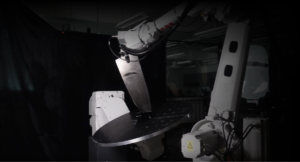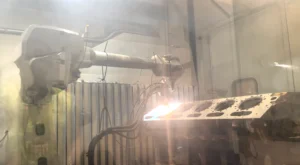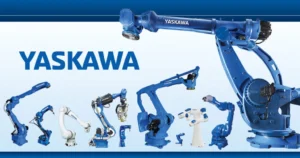table of contents
- Heading 1
- Heading 1
- Heading 1
share this
Arc welding is a cornerstone of modern manufacturing and construction. From massive skyscrapers to delicate sculptures, the impact of arc welding is immense and omnipresent. In this blog, we’ll delve into the fundamentals of arc welding, processes, arc welding types, and historical evolution. We’ll also examine the advantages and disadvantages of different arc welding methods, discuss their applications across various industries, and highlight the importance of safety in automated arc welding. Let’s dive in.
What Is Arc Welding?
Arc welding, in simple terms, is the process of joining two metals using an electrical arc. The heat generated during the process melts the metals at the joint. This allows them to fuse upon cooling, producing durable welds.
Now that you know “what is arc welding?”, let’s understand how it works.
How Does Arc Welding Work?
Arc welding creates a powerful electric arc between the electrode and the workpiece. An arc builds up when the electrode comes in contact with the workpiece. This produces intense heat This heat melts the metal in the joint, causing it to fuse
The electrodes are of two types: consumable and non-consumable. Consumable electrodes melt along with the heat and become a part of the final weld. Non-consumable electrodes don’t melt and just provide the arc. Often, shielding gas, flux, or vapors are used to protect the weld area from the environmental air. This keeps it clean and durable.
The Evolution of Arc Welding
It all started in the late 19th century. Auguste de Méritens set the foundation for arc welding, which at that time used carbon. Later in 1887, Nikolai Bernardos and Stanislaw Olszewski finalized the method and patented the first practical arc welding method that used a carbon electrode.
In the 20th century, welding saw a few advancements through Strohmenger and Kjellberg in 1900. They introduced coated electrodes which improved arc stability and weld quality
During World War 1, welding techniques saw significant improvements due to the demand. The war in various ways needed efficient and robust metal joining methods. This led P.O. Nobel to come up with automatic welding in 1920 and the development of submerged arc welding in the 1930s.
Post World War 2, gas tungsten arc welding and gas metal arc welding became prominent. These offered higher precision and efficiency better-suiting aerospace and automotive needs. And in the 1950s and 60s came the development of electron beam welding and laser welding.
Robotic arc welding emerged as a powerful innovation in the latter half of the 20th century. The integration of robots into welding processes began in the 1960s with the advent of the first industrial robots like UNIMATE. This advent set new standards for consistency and productivity.
Today these robots produce large volumes of weld outputs and have also reduced labor costs. These systems use advanced sensors and machine learning algorithms to adapt to variations in the workpiece. This improvement has made the construction industry safer, more productive, and highly efficient.
Advantages and Disadvantages of Arc Welding
Now that we’ve answered the question “what is arc welding?”, let’s understand its pros and cons. Arc welding, like any technology, comes with its own set of strengths and challenges. Let’s understand what makes this method a popular choice in various industries, and the potential limitations you need to be aware of:
Advantages of arc welding
- It is suitable for a wide range of metals including steel, stainless steel, and cast iron. This makes it suitable for a wide range of applications and versatile.
- The equipment and materials used for arc welding are inexpensive compared to other welding methods.
- Arc welding machines are easy to transport and use in different locations, especially in field maintenance.
- Provides a strong and durable weld. It is ideal for heavy-duty applications such as construction and shipbuilding
- Needs fewer pieces of equipment. This reduces the need for extensive storage.
Disadvantages of Arc Welding
- High-end welding needs a great deal of skill and experience. This makes it less suitable for beginners without formal training.
- Produces harmful fumes and strong UV rays. It is important to use protective gear to protect the health of the welder.
- Compared to TIG welding and other methods, it is not suitable for thin or delicate materials.
- Adverse conditions such as wind or rain can affect the quality of the weld. These conditions can damage and contaminate the arc.
4 Types of Arc Welding Methods
Arc welding encompasses a range of techniques, each with its own advantages and applications. Here’s a simple guide to the four most common arc welding types:
Shielded Metal Arc Welding (SMAW)
Also known as stick welding, SMAW is one of the oldest and most common welding methods. It uses a consumable electrode coated in flux to lay the weld. The electrode melts and fuses with the base metal, creating a strong joint.
During welding, the flux coating evaporates, creating a gas layer that protects the weld area from contamination. Stick welding is widely used in construction, maintenance, and repair work.
Advantages:
- Versatile and suitable for various metals and thicknesses.
- Portable and does not need an external shielding gas.
Limitations:
- Slower compared to other methods.
- Requires frequent electrode replacement.
- Produces slag that needs cleaning.
Gas Metal Arc Welding (GMAW/MIG)
GMAW, or MIG (Metal Inert Gas) welding, uses a continuous wire feed as a consumable electrode and an external shielding gas to protect the weld from contamination. The wire is fed through a welding gun, which creates an arc between the wire and the workpiece.
This melts both the wire and the workpiece resulting in their fusion and a strong weld. This type of welding is common in automotive, manufacturing, and fabrication industries.
Advantages:
- Faster welding process.
- Produces clean welds with minimal slag.
- Easier to learn for beginners.
Limitations:
- Requires a shielding gas, which can be cumbersome to handle.
- Not ideal for outdoor work due to wind affecting the gas coverage.
Gas Tungsten Arc Welding (GTAW/TIG)
It is also known as tungsten inert gas (TIG). This type of arc welding uses passive tungsten electrodes to make the weld. The electrode creates an arc that melts both the base metal and the filler rod.
This usually creates a strong fusion between the two. But you can also use a separate filler material if necessary. Due to its accuracy and clean welding properties, it is used in industries like aerospace, automotive, etc.
Advantages:
- Produces high-quality and accurate weld.
- Ideal for welding thin materials and nonferrous metals such as aluminum and magnesium.
- The welding process is more controllable.
Disadvantages:
- Slower than other welding methods.
- It requires a high level of skill.
- It is more expensive because of the need for external shield gas and other equipment.
Flux Core Arc Welding (FCAW)
Like MIG welding, FCAW uses a continuous wire feed but with a flux core that eliminates the need for external shield gas. The flux core in the wire melts and forms an insulating gas to protect the weld area.
The wire electrode is continuously fed through the welding gun, causing the underlying metal to melt and fuse. This type of welding is used in construction, heavy equipment maintenance, and shipbuilding.
Advantages:
- Higher deposition rates, making it faster than SMAW.
- Ideal outdoors because it doesn’t rely on external gas.
Disadvantages:
- It produces more smoke and fumes than any other method.
- It can be expensive due to the cost of flux-cored wire.
Arc welding applications
Arc welding is a versatile technique that can produce durable welds used in a variety of industries. Arc welding uses are far-reaching. Here is a look at how industries use it.
1. Construction
Arc welding is an integral part of the construction of buildings, bridges, and other structures. It provides strong joints which are important for structural integrity. Stick Welding is the most common type used for versatility and portability. This makes it ideal for on-site applications.
2. Automotive industry
Arc welding is heavily used in car manufacturing and repair. Techniques like MIG welding are used for their speed and the ability to produce clean and precise welds. This is critical to improve the strength and stability of automotive bodies.
3. Shipbuilding
Arc welding ensures joint waterproofing and durability. This is critical for the safety and durability of the vessel. Techniques such as Flux-Cored Arc Welding (FCAW) are used for their high deposition rates and efficiency.
4. Aerospace
The aerospace industry demands high-quality and reliable welding. So, for accurate welds and to handle thin, lightweight materials, TIG welding is preferred.
5. Manufacturing
Arc welding is foundational for making from small household items to large industrial machines. It offers great flexibility and efficiency. Techniques, like Submerged Arc Welding (SAW), produce high-quality welds in heavy construction. It offers deep penetration and minimal contamination.
6. Arts and Crafts
Artisans and sculptors also use arc welding to create metal objects and sculptures. Techniques like TIG welding allow for detailed and intricate work. This gives craftsmen the precision needed to create stunning designs and smooth finishes.
Besides these, arc welding finds applications in many other fields. This includes the railways, storage, marine, renewable energy, and so on. This demonstrates its broad utility and importance.
Ensuring Safety in Automated Arc Welding
Safety is important in any welding operation. Despite the advancements in technology, welding remains a high-risk activity that requires stringent safety measures. Here are a few practices that ensure safety the safety of your welder and his environment:
1. Proper training
Operators and maintenance personnel must have adequate training in handling and programming robotic welding systems. This includes understanding the system functionalities, safety measures, and emergency procedures.
2. Protective Equipment
Welders must wear appropriate personal protective equipment (PPE). Wearing a welding helmet, gloves, flame-retardant clothing, and safety glasses can protect them against heat, electric shock, and harmful nuclear radiation.
3. Regular maintenance
Regular inspection, maintenance, and software updates of robotic welding systems are critical. Checking for these ensures that all components are working as intended.
4. Adequate ventilation
Adequate ventilation is important to eliminate fumes and harmful gases generated during welding. This is to prevent respiratory issues and create a healthy work environment.
5. Safety Barriers and Sensors
It is important to have safety barriers, light curtains, and proximity sensors around the welding area. This stops unauthorized entry and keeps humans away from the operational area of the robot during welding.
6. Emergency Stops
All weld robots must have easily accessible button-mounted safety devices. So, in case of malfunction or imminent danger, accidents can be prevented.
7. Fire protection
Fire extinguishers and other fire safety equipment should be readily available in the welding area. Training is essential to use the equipment and follow the basic fire safety procedures in the event of a fire.
8. Electrical protection
All electrical components need proper grounding and insulation to prevent electrical shocks and short circuits. With routine inspections, it becomes easy to ensure that all electrical connections comply with safety standards.
Conclusion
Arc welding is almost everywhere, used in one method or the other. Each type of arc welding method offers unique advantages and fits perfectly for specific applications. As industries advance, achieving quality welds at high efficiency and safety becomes a norm.
Robotic systems have revolutionized arc welding, meeting the growing demands of modern industries. To stay competitive, companies must adapt to these advancements. Discover how Augmentus’ vision-guided offline robot programming software can significantly enhance your arc welding operations. Schedule a demo today!



